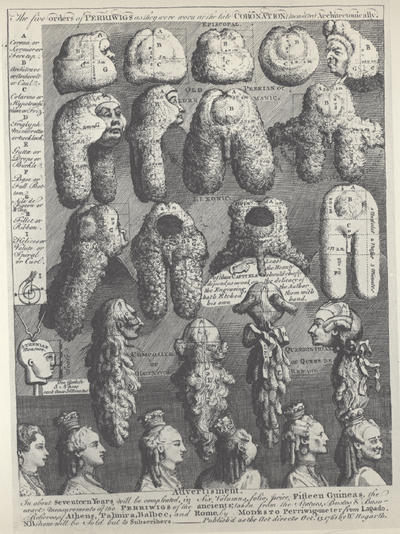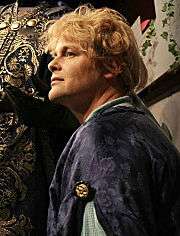Lace wig

A lace wig or a lace front wig is a special type of hairpiece or wig in which human hair or synthetic hair is tied by hand to a sheer lace base which goes over the scalp.
History
Wigs have been used since antiquity as hairstyle and costume; ancient Egyptians wore wigs to shield their shaved heads from the sun. They also wore the wigs on top of their hair using beeswax and resin to keep the wigs in place. Other ancient cultures, including the Assyrians,[1] Phoenicians, Greeks and Romans, also used wigs as an everyday fashion.[2] There was intermittent use of wigs in many cultures throughout history including the prophylactic use of them in England in the 1600s to help protect from head lice.
The modern wig was adopted by Louis VIII to cover his baldness.[3] By the late 1600s, both wigs and handmade lace headpieces were common with European and North American upper classes as daily fashion. Wigs were made of human, horse, and yak hair and sewn onto a frame with silken thread were meant to be obvious as wigs and not the wearer's actual hair.[2] Powdered wigs in rows of curls, known as periwigs, were adopted as court dress in many cultures with elaborate curls and style.

After the American Revolutionary War, styles in North America changed and the wig as a sign of social class died out of use.[2][4] Wigs began to be used more to augment natural hair for elaborate hairstyles, for religious reasons, or to cover hair loss in both genders and therefore were required to blend with the wearer's natural hair. The selling of human hair by the lower classes for use in wigs by the upper classes was captured in stories like Gift of the Magi and Little Women.
In the 19th century a new wig-making method began to replace the weft method most commonly used prior. A small hook called a "ventilating needle", similar to the tambour hooks used for decorating fabric with chain-stitch embroidery at that period, is used to knot a few strands of hair at a time directly to a suitable foundation material.[5] By the 1870s, the lace machine had made lace affordable through mass production and the use of lace as foundation material for wigs entered popular use.[4] Using lace allowed for a more natural-looking wig because the flesh-colored lace is almost imperceptible.[6] The more common use was a strip of lace just at the front, known as a lace front wig, which gives the impression of a natural hairline.[7][8]
Modern usage
Full lace wigs may have a base made entirely of lace. Full lace wigs can be pulled into a high ponytail and up-do's, as opposed to lace front wigs. If a lace front wig is pulled back, it is usually obvious that it is a wig.[9]
Lace front wigs are more common and the remainder of the wig is made out of a less fragile material which is less susceptible to ripping or tearing than the lace.[8] The lace front wig allows the wearer to choose a hairline.[8] The lace is only in the front half of the wig, to allow the wearer to part the hair any way he or she wants.
The lace wig is usually attached with the assistance of glues and tapes, which are applied to the front hairline area. Once the glue has dried, the front lace portion of the wig is affixed to the area where the glue has been applied on the hairline, creating a tight bond which keeps the lace wig in place on the head. Some lace wigs also have what is referred to as "baby hair" around the temple areas which is used to cover up any visible signs of lace on the forehead, and the baby hair also helps to create a realistic hairline. Once applied the lace or lace front wig can stay in place for weeks at a time and maintained with shampoo and styling in the meantime.[6]
Lace Wig Density
This refers to how thick or thin hair on the wig (commonly referred to as a unit) features. Lace wig density is measured as a percentage (%). The higher the percentage the thicker the hair density on the unit.
References
- ↑ "Dumuzid and Jectin-ana". Etcsl.orinst.ox.ac.uk. 2006-12-19. Retrieved 2013-01-16.
- 1 2 3 Sherrow, Victoria (2001). For appearance' sake : the historical encyclopedia of good looks, beauty, and grooming. Phoenix, Ariz.: Oryx Press. ISBN 1573562041. Retrieved 22 May 2015.
- ↑ Picken, Mary Brooks (1999). A dictionary of costume and fashion : historic and modern : with over 950 illustrations (Reprint ed.). New York, NY: Courier Corporation. p. 375. ISBN 0486141608. Retrieved 22 May 2015.
- 1 2 Sherrow, Victoria (2006). Encyclopedia of hair : a cultural history (1. publ. ed.). Westport, Conn.: Greenwood Press. pp. 404–410. ISBN 0313331456. Retrieved 22 May 2015.
- ↑ "History of Wig Making". Freeda. Retrieved 21 November 2014.
The modern method for making wigs was developed by wig-makers guilds in France during the 19th century. Here the hair is directly woven onto the foundation material (usually a flesh colored net) using a ventilating needle (similar to the needles used for embroidery). This process resulted into wigs that fitted snugly to the head, thus looking more “natural” than wigs produced using the weft method.
- 1 2 Byrd, Ayana D.; Tharps, Lori L. (2014). Hair story : untangling the roots of black hair in America (First revised edition. ed.). ISBN 9781466872103.
- ↑ Breslin, Marquetta. "Black Hair Answer Book". New York, NY: RMNC Publishing (Amazon).
- 1 2 3 Lowery, Alison (2013). Historical Wig Styling: Ancient Egypt to the 1830s: (The Focal Press Costume Topics Series). Taylor & Francis. p. 177. ISBN 9781136085970. Retrieved 22 May 2015.
- ↑ McElroy, Dana Kathleen (2010). Magic Hair: My Experiences With Lace Wigs. CreateSpace Independent Publishing Platform. ISBN 9781451554755.